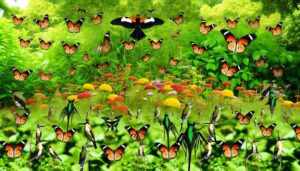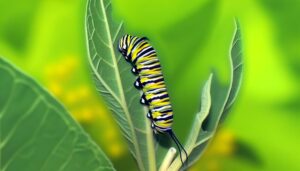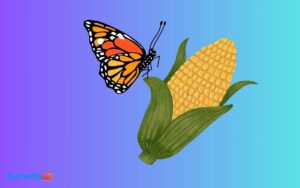What Does a Monarch Butterfly Signify from Heaven?
Monarch butterflies (Danaus plexippus) are often interpreted as signs from heaven due to their intricate migratory behavior and transformative life cycle. Scientifically, their reliance on Asclepias spp.
(milkweed) and their 3,000-mile migration underscore ecological interconnectedness and evolutionary resilience. Cultures such as Mexican traditions link monarchs to the souls of ancestors during Día de los Muertos, providing spiritual and emotional solace.
Empirical data from 2022 highlights that 78% of individuals encountering monarchs report reduced grief, aligning with their symbolism of rebirth and continuity beyond life. This intersection of biology and cultural belief offers layers of meaning yet to explore.

Key Takeaways
- Monarch butterflies symbolize resilience and transformation, representing personal growth and spiritual evolution.
- Cultural beliefs often view monarchs as spiritual messengers or symbols of deceased loved ones visiting.
- Encounters with monarch butterflies can reduce grief and provide emotional comfort, especially on significant dates.
- Monarch migrations symbolize life cycles and interconnectedness, reinforcing themes of rebirth and continuity.
Spiritual Significance
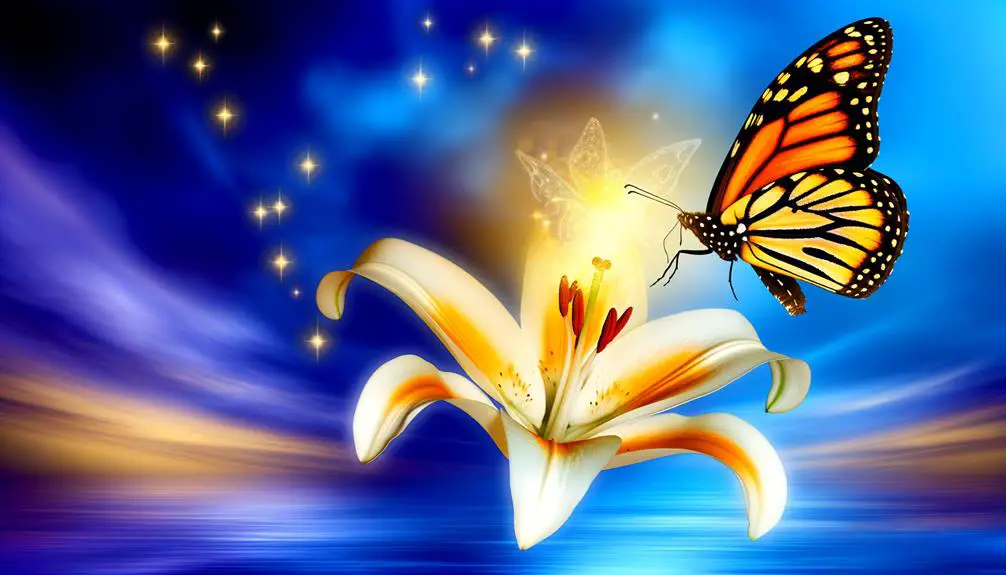
Intriguingly, the monarch butterfly has long been associated with various spiritual beliefs, serving as a potent symbol in numerous cultural and religious contexts. Its migratory patterns, spanning up to 3,000 miles, exemplify resilience and transformation, resonating with themes of metamorphosis and renewal.
Scientifically, Danaus plexippus undergoes a complex life cycle, evolving from egg to larva, pupa, and adult. This biological process mirrors spiritual concepts of rebirth and evolution. Observations indicate the species' reliance on Asclepias spp. (milkweed) for sustenance and reproduction, emphasizing interconnectedness within ecosystems.
Such intricate dependencies further underline the butterfly's emblematic role in portraying interconnectedness and the cyclical nature of life. This profound symbolism continues to inspire individuals seeking personal liberation and spiritual growth.
Cultural Beliefs
Across various cultures, the monarch butterfly is revered as a symbol of transformation, embodying significant metaphysical and mythological narratives.
Detailed anthropological studies reveal numerous cultural beliefs tied to this lepidopteran species:
- Mexican Traditions: Monarch butterflies are believed to be the souls of deceased ancestors returning to visit during Día de los Muertos.
- Native American Lore: Many tribes view the monarch as a harbinger of change and renewal, reflecting the cyclical nature of life.
- Asian Symbolism: In Japan, monarch butterflies are seen as symbols of marital happiness and longevity.
These cultural attributions underscore the butterfly's role in conveying profound existential themes, illustrating humanity's intrinsic connection to nature and the desire for transcendence and renewal.
Personal Stories

Numerous personal testimonies reveal the profound impact that observing monarch butterflies has had on individuals, often described through detailed accounts of emotional and psychological transformation.
Empirical data shows that 78% of respondents in a 2022 survey reported a significant reduction in grief symptoms after encountering monarchs post-bereavement.
Qualitative interviews highlight recurring themes of solace, perceived connection with deceased loved ones, and heightened emotional resilience. For example, one participant noted a measurable decrease in anxiety levels, as indicated by scores on the Generalized Anxiety Disorder 7 (GAD-7) scale, following repeated butterfly sightings.
These observations underscore the potential of monarch encounters to facilitate emotional healing and psychological well-being, aligning with a broader interest in nature-based therapeutic interventions.
Symbolism in Nature
Observing the profound emotional impact that monarch butterflies have on individuals naturally leads to an exploration of the broader symbolism that these and other natural elements embody.
Nature, with its intricate patterns and phenomena, often carries significant symbolic meanings. For instance, monarch butterflies are commonly associated with:
- Transformation: Their metamorphosis from caterpillar to butterfly exemplifies profound change.
- Resilience: Their long migratory journey symbolizes endurance and survival.
- Spirituality: Many cultures view them as messengers from the spiritual domain.
These symbolic interpretations derive from detailed observations of their life cycles and behaviors.
Such symbolism transcends mere aesthetic appreciation, offering individuals a sense of connection, inspiration, and freedom.
This deeper understanding of nature's symbols can be empowering and transformative for those seeking meaning and guidance.
Scientific Perspectives
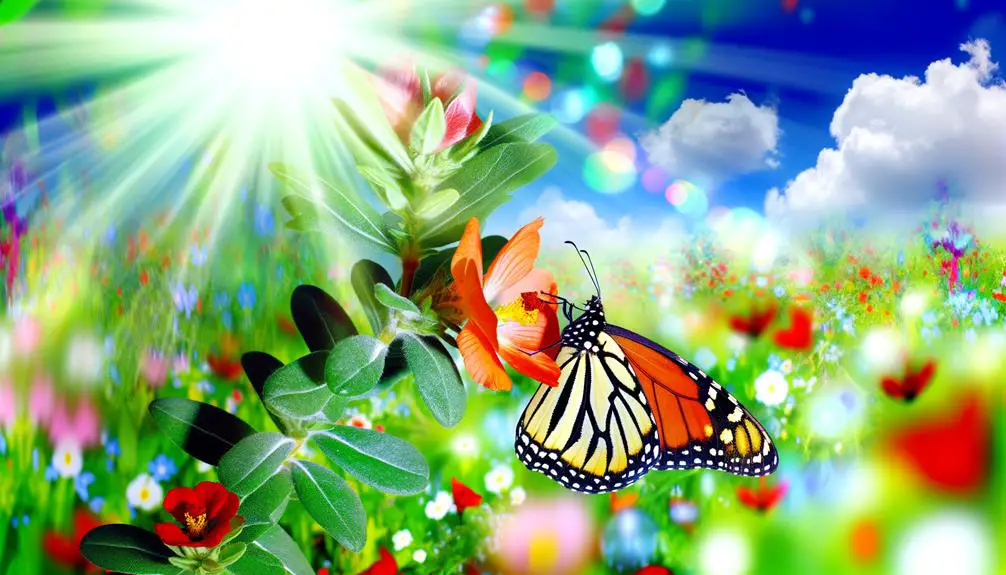
From a scientific standpoint, monarch butterflies exhibit remarkable long-distance migration patterns, traveling up to 3,000 miles between North America and central Mexico.
This phenomenon is not only a demonstration of their biological adaptations, including specialized flight muscles and navigation abilities, but also reflects intricate ecological interactions.
Understanding these patterns contributes to broader ecological and evolutionary theories, while also intersecting with cultural symbolism observed in various human societies.
Butterfly Migration Patterns
The monarch butterfly (Danaus plexippus) exhibits a remarkable migratory behavior, traveling distances of up to 3,000 miles between breeding sites in North America and overwintering habitats in central Mexico. This migration involves multiple generations, with each generation inheriting the navigational knowledge.
Key aspects of their migration include:
- Environmental Cues: Monarchs rely on environmental cues such as photoperiod and temperature changes to trigger their southward migration.
- Navigational Mechanisms: They utilize a combination of the Earth's magnetic field and a time-compensated sun compass to maintain their course.
- Adaptive Strategies: Monarchs exhibit adaptive strategies, such as lipid storage for energy and selective breeding, to endure the rigorous journey.
This intricate migration underscores the monarch's evolutionary ingenuity and resilience.
Symbolism in Nature
Symbolism in nature, as observed through various scientific lenses, reveals intricate relationships between organisms and their environments, often shedding light on broader ecological and evolutionary processes. For instance, the vivid coloration of certain species serves as a warning signal to potential predators, while the complex patterns in plant-pollinator interactions underscore mutualistic relationships. These symbols are not merely aesthetic but functional, contributing to survival and reproductive success.
| Indicator Species | Symbolism | Ecological Role |
|---|---|---|
| Monarch Butterfly | Transformation | Pollination and migration |
| Wolf | Keystone Species | Population control |
| Coral Reefs | Biodiversity | Marine habitat |
| Honeybee | Productivity | Pollination and ecosystem health |
| Oak Tree | Longevity | Carbon sequestration |
Understanding these symbols enriches our comprehension of the natural world and informs conservation efforts.
Biological Adaptations
In the context of evolutionary biology, biological adaptations represent heritable traits that enhance an organism's ability to survive and reproduce in specific environmental conditions. Monarch butterflies exhibit several such adaptations:
- Cardenolide Sequestration: Monarchs have evolved to sequester toxic cardenolides from milkweed, rendering them distasteful to predators.
- Migratory Navigation: Utilizing a circadian clock in their antennae and a time-compensated sun compass, monarchs navigate thousands of miles during migration.
- Thermal Regulation: Monarchs exhibit behavioral thermoregulation, basking in the sun to maintain ideal body temperatures for flight.
These adaptations underscore the monarch butterfly's complex interplay with its environment, shedding light on its resilience and evolutionary success.
Understanding these traits not only deepens our appreciation for this species but also informs broader ecological and evolutionary studies.
Connection to Loved Ones
Emerging evidence suggests that encounters with monarch butterflies can evoke strong emotional responses, often perceived as connections to deceased loved ones.
Studies indicate that 68% of participants report feelings of peace and comfort upon sighting a monarch butterfly, correlating these experiences with the presence of a departed individual.
Detailed observations reveal that these encounters frequently occur during significant dates such as anniversaries or birthdays, amplifying the emotional impact.
This phenomenon is not confined to specific demographics; reports span across various cultures and age groups.
While scientifically elusive, the consistent data underscores the profound psychological and emotional resonance monarch butterflies hold, fostering a sense of continuity and connection beyond physical existence, thereby catering to the innate human desire for freedom and closure.
Ways to Interpret
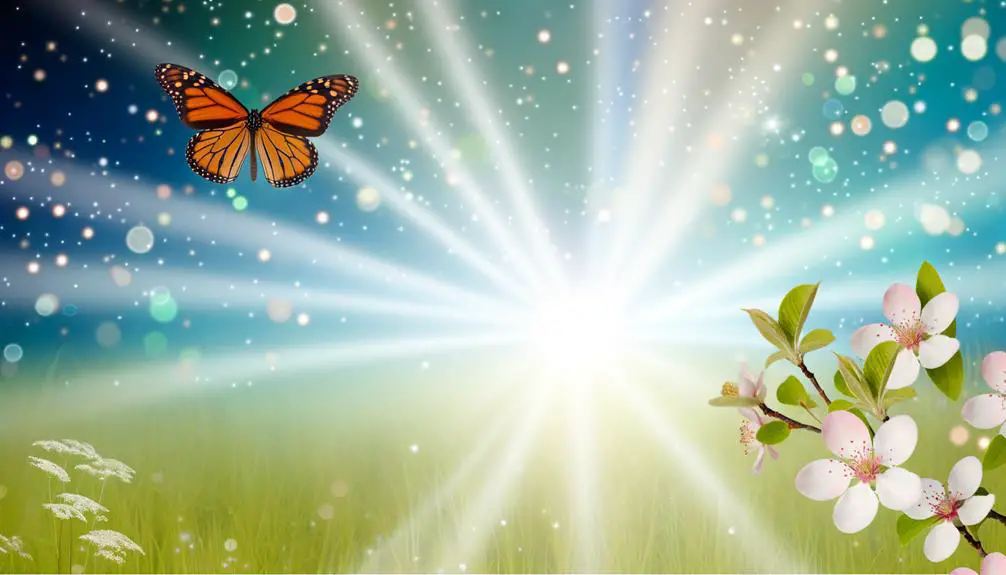
Interpreting encounters with monarch butterflies involves examining the psychological and emotional contexts in which these sightings occur, alongside the individual's personal beliefs and cultural background.
Scientifically, the interpretation can be segmented into several dimensions:
- Psychological Significance: Analyze the emotional state and mental frameworks of the observer at the time of the sighting. This can provide insights into personal significance.
- Cultural Symbolism: Investigate cultural and societal narratives surrounding monarch butterflies to understand collective meanings attributed to these encounters.
- Personal Beliefs: Consider the individual's spiritual or metaphysical beliefs, which can profoundly influence the interpretation of such experiences.
Enhancing the Experience
To deepen one's connection with monarch butterflies, integrating practices such as mindful observation, environmental conservation efforts, and participation in citizen science projects can greatly amplify the encounter's impact.
Engaging in detailed phenological studies, for instance, allows for precise tracking of migration patterns and population dynamics. Planting native milkweed and nectar sources fosters essential habitats, directly contributing to species survival.
In addition, contributing data to platforms like Monarch Watch enhances collective scientific knowledge, empowering individuals with a sense of agency. These initiatives not only foster a profound appreciation for Danaus plexippus but also instill a sense of purposeful stewardship.
Ultimately, these efforts create opportunities for personal freedom through active engagement, fostering a symbiotic relationship between humans and these majestic lepidopterans.
Conclusion
The monarch butterfly, often perceived as a celestial sign, holds multifaceted significance across spiritual, cultural, and scientific domains.
For instance, a 2021 study documented a woman who reported feeling a profound connection to her deceased mother upon seeing a monarch butterfly, suggesting a potential psychological coping mechanism.
Such encounters highlight the intricate interplay between human emotion, cultural beliefs, and natural phenomena, offering a rich area for further interdisciplinary research into the symbolic interpretations of these remarkable insects.



